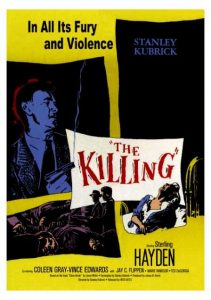You get the impression that Sterling Hayden’s two-time loser Johnny Clay never read much Steinbeck in prison. If he had at least thumbed through Of Mice and Men, he would never have agreed to work with misfits and animals. Johnny may speak like George Milton, but his look is all Lennie Small.
Kubrick’s heist movie, “The Killing,” trades in a pup for a racehorse but the result is largely the same: small men and women crushed by their own shortcomings in pursuit of the American dream. Purgatory for Clay is no longer a ranch, but the cesspool of Los Angeles, full of glistening, false promise.
Like every other hood Clay has the perfect caper: a $2 million dollar racetrack heist planned to the exact minute. The best laid plans of mice and men often go awry and with Clay’s dysfunctional insiders they are bound to fail spectacularly. Johnny is a classic fantasist and sweeps everyone up with his staccato professionalism, himself included.

Looking at Clay’s bunch of desperate amateurs doesn’t exactly inspire confidence in their ability to function in everyday society. Johnny expects them to steal a fortune from under the noses of thousands. Is he mad? Maybe not, but he is delusional, trusting in a bent cop, a cuckolded cashier, a recovering alcoholic, and a trackside barman with his dream – just as Steinbeck’s George Milton thought that Candy and Crooks could rescue Lennie and himself from their own perpetual isolation.
Much to our surprise, the robbery runs like clockwork. The scene is deftly edited by Betty Steinberg, so we get to watch each gang member’s participation to its climax before rewinding back to the start of the race to see another begin. A lesser director would rely on cross-cutting between the protagonists to build tension, but the chess player in Kubrick prefers a logical approach that pays off handsomely once the crime has been successfully committed.
The fly in Clay’s ointment, like the thorn in George’s side, is a woman. Bored, frustrated and unfulfilled, Sherry Peatty worms the plan out of her snivelling cashier husband. In true noir style she can see the dollar bills flashing before her eyes and enlists her young lover Val to loot the loot. Sherry may be more conniving than Curley’s wife, but in her own way she’s just as tragic. Both have had their heads turned by the silver screen, their unattainable dreams piped to them from Hollywood – only to disappear with their lonely, useless deaths.
Clay lucks out when Val’s stick-up descends into a massacre leaving him with all of the money. Hayden’s granite face barely registers Clay’s disbelief as he skulks away with his grisly ransom. A sap like Clay could never really hold onto his dream though, no matter how close he gets to it. He is his own Lennie, too cumbersome, too emotionally stunted to succeed. It’s immaterial that he’s a criminal, because Clay would also lose a fortune secured legitimately. He is cut from the same stuff as Kubrick’s Barry Lyndon, good at securing a fortune but better at losing one.
And what a way to lose one, scuppered by a dog and a lousy suitcase, Clay’s dollar dreams are blown all over the runway. His point of view is slowly closed in by two agents, unnervingly reminiscent of pod people from “Invasion of the Body Snatchers.” Perhaps this time, in prison, Johnny will have longer to brush up on the fates of Lennie and George.

One thought on “On the 10th anniversary of Kubrick’s passing: “The Killing””
Comments are closed.